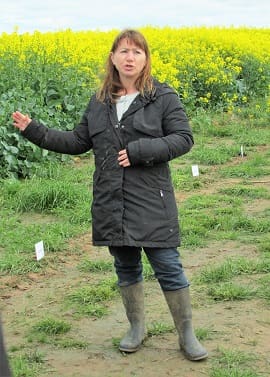GRAIN growers in southern Australia’s high rainfall zone (HRZ) have the potential to increase their wheat and canola yields by an average of 50 per cent, according to yield modelling.
The difference between today’s reality and tomorrow’s potential – known as the ‘yield gap’ – is the focus of a concerted research effort to enable growers to extract a great deal more from their crops.
Through the Grains Research and Development Corporation’s (GRDC) ‘Optimising the yield and economic potential of high input cropping systems in the HRZ’ investment, researchers are developing new knowledge, tools, resources and recommendations to push yields and improve grower profitability.
Agriculture Victoria is leading the research initiative which has established that by providing sufficient nutrients, wheat and canola yields can approach water-limited potential, except in cases of severe waterlogging or drought.
Agriculture Victoria Hamilton-based senior research scientist, Penny Riffkin, said the project had three main components, outputs from which would enhance understanding of crop physiology in order to identify crop types better suited to the HRZ and also inform growers’ tactical decision-making in their quest to bridge the yield gap.
“The first component is focusing on ideal wheat types that are better suited to this region, in terms of phenology and canopy architecture,” Ms Riffkin said.
“The second component involves looking at canola types – again phenology and canopy architecture – ideally suited to the HRZ, while the third component is looking at how, with these optimum crop types, we can achieve higher yields through better management, in particular optimum nutrition.”
The nutrition component of the research involves trials of wheat and canola, with the research focusing on the interactions between multiple nutrients, including nitrogen (N), phosphorus (P), potassium (K), sulphur (S) and micronutrients.
Research data from numerous field experiments across multiple sites is providing a better understanding of the responses to nutrients, both positive and negative.
“It could be that putting on more nutrients will give you a 30 percent yield increase, or in some cases it could even give you an 80 per cent yield increase, but it may not be economical to do so,” Ms Riffkin said.
“Also, growers may not be necessarily getting the response to nitrogen (N) that they were expecting and it could possibly be due to a lack of other nutrients, such as P, K and S.”
While N decisions can be made in-crop, a key finding from the research to date is that decisions relating to the application of phosphorus, potassium and sulphur must be made before the crop is sown.
“The crop response will be limited by the nutrient which is most limited,” Ms Riffkin said.
“We really need to have P, K and S levels sufficient at the start of the season in order to achieve good crop establishment and good growth, particularly in the HRZ where you might have the need for crops to be able to out-compete weeds or become a reasonable size before the onset of waterlogging.”
To help growers navigate these nutrition variables and to achieve the most profitable yields, three Excel-based decision support tools are under development to determine the economic optimum rate of macronutrients under various conditions.
“Growers can input their location, their crop type, the expected water limited yield of those crops, input costs and product price, plus there is also the provision to adjust that information depending on evolving seasonal conditions,” Ms Riffkin said.
“From that input, growers will be given the optimum combination of different nutrients – amount and type – to give them the best opportunity to achieve optimum yields from their wheat and canola.”
The Excel tools (available but still in development) are currently populated for several sites in southern Victoria and the South-East of South Australia. The tools are being tested on-farm and more sites will be added soon, including one for Tasmania.
The tools can be downloaded free of charge via the GRDC Communities website at goo.gl/ji99PB.
Source: GRDC


HAVE YOUR SAY